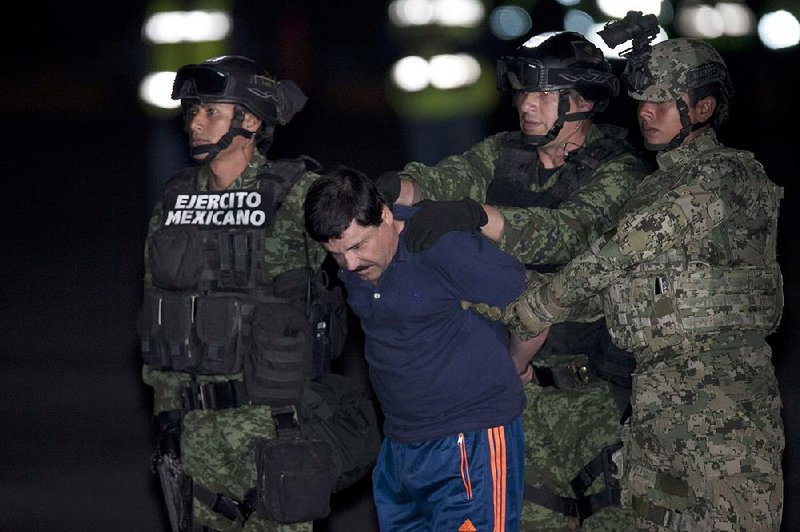MEXICO CITY -- Mexico is willing to extradite drug lord Joaquin "El Chapo" Guzman to the United States, a federal law enforcement official said Saturday. It's a sharp reversal from the official position after his last capture in 2014.
"Mexico is ready. There are plans to cooperate with the U.S.," said the official, who spoke on condition of anonymity because he wasn't authorized to comment.
But he cautioned that there could be a lengthy wait before U.S. prosecutors can get their hands on Guzman, the most-wanted trafficker who was recaptured Friday after six months on the run: "You have to go through the judicial process, and the defense has its elements too."
Top officials in the party of President Enrique Pena Nieto also floated the idea of extradition, which they had flatly ruled out before Guzman's embarrassing escape from Mexico's top maximum-security prison on July 11.
"He has a lot of outstanding debts to pay in Mexico, but if it's necessary, he can pay them in other places," said Manlio Fabio Beltrones, president of Pena Nieto's Institutional Revolutionary Party.
In 2014, then-Attorney General Jesus Murillo Karam told The Associated Press that he wouldn't accept El Chapo's extradition to the U.S. until after the drug dealer had completed his sentence in Mexico, "300 or 400 years later."
A U.S. extradition request made before Guzman's recapture is still active, and the attorney general's office, a Mexican judge and the Foreign Ministry will all be involved in its review, according to three officials, who asked not to be named talking about the administration's private deliberations. The likelihood for Guzman's lawyers to present legal motions to block extradition make a schedule for the move impossible to estimate, they said.
But even if Mexican officials agree, Guzman's attorney Juan Pablo Badillo told the Milenio newspaper that the defense already has filed six motions to challenge extradition requests.
"They can challenge the judge, challenge the probable cause, challenge the procedure," said Juan Masini, former U.S. Department of Justice attache at the U.S. Embassy in Mexico. "That's why it can take a long time. They won't challenge everything at once ... they can drip, drip, milk it that way."
Guzman, a legendary figure in Mexico who went from a farmer's son to the world's top drug lord, was apprehended after a shootout between gunmen and Mexican marines at the home in Los Mochis, a seaside city in Guzman's home state of Sinaloa.
The operation resulted from six months of investigation by Mexican forces, who located Guzman in a rural part of Durango state in October but decided not to shoot because he was with two women and a child, said Mexican Attorney General Arely Gomez.
After that Guzman took a lower profile and limited his communication until he decided to move to Los Mochis in December.
After the capture of Guzman -- the head of the powerful, international Sinaloa Cartel -- he was taken to Mexico City's airport, marched to a helicopter before news media, and flown back to the same prison he'd fled.
There were immediately calls for his quick extradition, just as there were after the February 2014 capture of Guzman, who faces drug-trafficking charges in several U.S. states. At the time, Mexico's government insisted it could handle the man who had already broken out of one maximum-security prison, saying he must pay his debt to Mexican society first.
Then Guzman escaped a second time on July 11 under the noses of guards and prison officials at Mexico's most secure lockup.
In celebrating Guzman's latest capture, Mexican officials showed none of their bravado of two years ago, though they made clear that the intelligence building and investigation were carried out entirely by Mexican forces. They did not mention extradition.
Gomez said that one of Guzman's key tunnel builders led officials to the neighborhood in Los Mochis, where authorities had been watching for a month. The team noticed a lot of activity at the house Wednesday and the arrival of a car early Thursday morning. Authorities were able to determine that Guzman was inside the house, she said.
The marines were met with gunfire as they closed in. Five suspects were killed and six others arrested. One marine was injured.
Gomez said Guzman and his security chief, "El Cholo" Ivan Gastelum, were able to flee via storm drains and escape through a manhole cover to the street, where they commandeered getaway cars. Marines climbed into the drains in pursuit. They closed in on the two men based on reports of stolen vehicles, and the suspects were arrested on the highway.
After his first capture in Guatemala in June 1993, Guzman was sentenced to 20 years in prison. He reportedly made his 2001 escape from the maximum-security prison in a laundry cart, though some have discounted that version.
Last year, he fled down a hole in his shower stall in plain view of guards into a mile-long tunnel dug from a property outside the prison. The tunnel had ventilation, lights and a motorbike on rails. Construction noise as a digger broke through from the tunnel to his cell was obvious inside the prison, according to a video of Guzman in his cell just before he escaped.
Mexican officials say dreams of Hollywood helped them track down and capture Guzman.
After his escape, he instructed his people to get in touch with actresses and producers. The government used the contacts between his people and those in the film industry to open a new line of investigation, according to Gomez.
Mexican intelligence was tracking Guzman's moves, helped in part by the feelers he had put out about the movie.
Information for this article was contributed by E. Eduardo Castillo, Katherine Corcoran, Mark Stevenson, Christopher Sherman, Eric Tucker of The Associated Press; Eric Martin of Bloomberg News; and Azam Ahmed of The New York Times.
A Section on 01/10/2016
